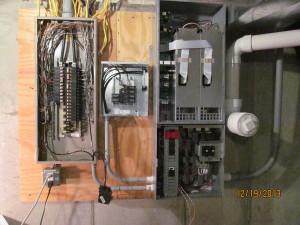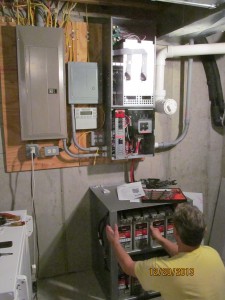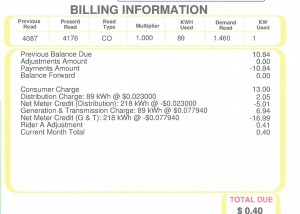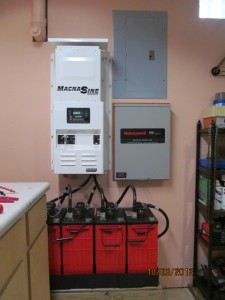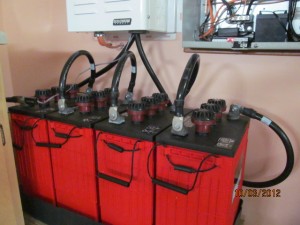I just received this announcement in an email from one of my many electronics industry sources. It describes a new filter, used by the military to protect sensitive electronic gear from EMP or equivalent events. Just thought I’d pass it on! HEMP Filter link
Tag Archives: Solar Installer
Adding battery backup – even if you DON’T have solar!
It’s been a while since I posted any new activities – but only because I’ve been so darned busy! A client in Harrison Indiana wanted a a solar system installed, but he launched his project too late in the year, so rather than fight the weather, we decided to just install the BACKUP portion of the project ahead of time – giving him the benefit of a backup system for the upcoming Winter season. He lives out in the country, and encounters frequent power outages during the winter months, so this was a good compromise, and that’s what this blog entry will be about.
We decided to go with the new OutBack RADIAN 8Kw inverter and the Outback AGM batteries, since they don’t require watering or venting. He had space on the wall where his current Main breaker panel was located, so we just expanded with some extra plywood. We hung the inverter and mounted the battery bank directly below it so that we would minimize the distance the 4/0 Battery cable would need to cover.
With that plan in mind, I went in search of some 1 inch plywood, which it seems none of the lumberyards carry. I got the lumberyard to precut a 4 X 8 sheet of 1/2 inch thickness, and managed to squeeze them into our PT cruiser. A couple squirts of glue and some 3/4 drywall screws to hold them together got us the mounting plate we needed for all the things we were going to add: a SUPPORTED LOAD panel – this is the loads that will be backed up when the power drops, another outlet for the freezer next to this panel, and the OutBack MATE3 control center that lets us program the Radian and observe the voltage and operation visually.
The MATE3 also provides the interface to the internet so that this can all be monitored from a PC on the web. We planned on adding solar this year when the weather warmed up, and the Radian PREWIRED INTERFACE took all the hassle out of making this all work. THe interface is directly below the Radian in the next photo. Everything inside this prewired box is clearly labeled and it would be VERY hard to get it hooked up wrong!
The next step was to move the breakers and wiring for the supported loads from the main panel (at the left) to the supported load panel (in the middle). The lines were too short by a couple of feet, so I went to the electrical supply house and found some neat nylon splice blocks that have compression screws and they come in big strips of 20 or 30, so I could cut them into blocks of 3. This allowed me to splice new romex (same gauge) to the black, white and copper ground wires in a manner that was safe and in compliance with the National Electrical Code.
The wood backing also allowed me to screw the splice blocks in place at the top of the board (out of reach) to keep things safe. Please notice that all connections between the breakerboxes, the inverter and anything else on this board are all in conduit. The only exception is the Romex, which by code is allowed. Just remember that EVERY line of romex going into the supported load panel MUST have a strain relief. You just can’t run wires through the holes in the box – it would NEVER pass an inspection!
While I was doing all that wiring, the homeowner was busily assembling the battery cabinet and installing the OutBack AGM (sealed lead acid gel type) batteries and all the jumpers to create the battery bank. There are two banks of four batteries, which are then paralleled to achieve a sizeable AmpHour capacity.
These batteries are not cheap, but they don’t require any attention like checking fluid level, or requiring a vent fan, so it simplifies the installation and use of the system. By the way, if you want a closer look, just click on the photos and you will get a full screen size view.
If you look close you’ll find that there is a 175Adc breaker for each ROW of batteries in the cabinet. This will come in handy troubleshooting in the future. It also keeps things safe while connecting the battery cables. The cable used in this setup is high strand count 4/0 with FACTORY TERMINATED ring ends. No, you CAN’T use welding cable, and don’t even THINK about putting ends on by yourself.
Always purchase SOLAR battery cables that are pre-terminated by your supplier. During normal operation DC current out of the battery can reach peaks upwards of 500 to 1000 AMPS. Any weak or loose connection will get hot and create a problem in no time!
Here’s the finished installation – just a few more lines to move from the main breaker panel over to the supported load panel. If you click on the photo, and zoom in, you can just make out those splice blocks I was talking about at the top. There was just enough room below the supported load panel to mount the Mate3, and the finished installation looks pretty nice with all the brushed steel panels and covers re-installed.
Other than the battery cabinet, the backup system didn’t take any additional floor space, so it was not a problem where we placed everything. The homeowner still needs to run an ethernet cable down a chimney chase from upstairs to put the system online – another project for a rainy day. I went back in the early Spring of this year to install the ground mount and a sunny boy inverter at the back of the property.
This is an old farm, and the service is sort of snaked around the property. By intercepting the feed to the barns, we will be able to redirect them THROUGH the RADIAN INVERTER PREWIRE BOX, and effectively create an awesome GRID BACKUP system that will operate AND Charge the batteries when the utility power is down. In Bright sun, we have 8KW from the inverter/battery bank COMBINED with 5 to 6KW of realtime solar power to run some BIG loads like AC or the washer/dryer.
If you look back at the 2nd picture, you can see TWO large boxes with cables coming from them. These are two 4Kw inverters. The RADIAN design is redundant- if one quits, you still have power, just 1/2 power. That’s better than NONE when the power is down. I think this is the best feature of the radiant design!
HOW MUCH CAN YOU CUT YOUR BILL WITH SOLAR?
It depends on how much roof space (or yard space) you have, and how many panels you install. A good average system size is 24 panels, which in most cases is a PALLET of panels, which gets you the best pricing. My home has 24 panels on it. 20 of them are 230 watt panels and 4 are 240 watts, added at a later date.
My house faces South West, and I have two large hills on the East and West side that shade my roof for an hour and a half in the morning and an hour before sunset. All that considered, here’s what I just got from the electric company on my most recent bill. It tells the story. I have gas heat, so this is just for my electric usage, but that includes AC in the summer months!
Warrantee work at East Fork
Had a small problem with an SMA Sunny Island grid backup inverter (6KW). After sending SMA the Smart Card data, they promptly sent out a replacement and even included return shipping! Back up and running and customer is a happy camper once again. Based on this event, I would highly recommend you look at the SMA Sunny Island if you’re planning a Grid backup or even OFF-grid system! Sorry, I forgot my camera this trip!
DIY Solar LOW electric bill!
Just a quick post. I’ve mentioned my little house in the country many times and I finally found the energy hog! It was my septic aerator pump. It’s a 3/4 horse air pump, and it was running far too often. I changed the timer settings and cut my biggest energy user by 70%. I added panel #13, and I think I’ve almost reached NET ZERO energy for this little house!
Nothing makes me happier than seeing a ZERO or near ZERO electric bill. Keep in mind, the solar also covers the fixed portion of the bill that is NOT electric usage. It renews my belief that doing this is the Right thing, right now.
Solar has never been more affordable, so if you plan on staying in your home for the next 20 years, CALL ME and I’ll show you how to do DIY SOLAR in a quick, effective and above all AFFORDABLE manner! It just makes good sense.
Backup System finished at Little House
Wow, it’s taken a while to get this posted, but I’ve got the grid-backup system completed at our little house (we fondly refer to it as THE BUNKER…). I was recently out there during a freak snow storm that dumped 5 inches of wet snow in about 2 hours, and when the power went out, there was just a slight flicker of the lighting as I was sitting at the computer checking my email. The UPS on the computer didn’t even get a chance to kick in! I excitedly went downstairs to the basement to check out the inverter, and sure enough, it was on line, quietly humming away, providing full power to the main electric breaker box for everything that was presently on in the house. The Magnum MS-PAE 4024 inverter can provide about 4,000 watts of continuous power until the batteries discharge 80% of their capacity. Since the house normally consumes only about 500 watts (average) power, this represents about 20 hours of run time. Fortunately, when the backup system is in operation, the solar PV system can “back feed” through the breaker box and provide the power the house needs as well as re-charge the batteries, so this setup can run pretty much indefinitely, as long as there is a few hours of sun each day. Even on a cloudy day, the 2.4KW (Twelve 220 watt panels) solar array provides about 500 watts, so that extends the capacity of the system pretty well.
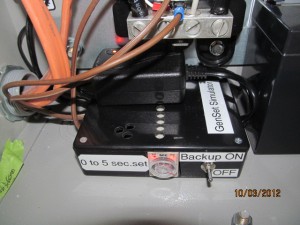
In order to make the TRANSFER SWITCH operate, I had to build my own little GENSET SIMULATOR. It connects to the output of the backup inverter and provides the necessary voltage and control signal to the transfer switch to make it kick over when the power goes out. These TRANFER SWITCHES are designed to normally work with a gas or diesel GENERATOR SET, as they are called.
It took a little studying and research, but I figured out how to SIMULATE the voltage and signals that normally come from a GENERATOR SET that would connect to a WHOLE HOUSE TRANSFER SWTICH on the V+, GROUND, and PIN 23. These are the 3 wires that are standard on any gas or diesel generator. Since I’m using an electronic inverter (Magnum MS-PAE 4024), such signals were not available, so I came up with a little box that has 2 relays in it. One is standard and the other is a 5 second delay unit so the system won’t “chatter” if power drops in/out rapidly. If you’d like the details on how to build one, I’ll be glad to send you a schematic. Just drop me a line at: Joe@cincihomesolar.com
These are the batteries I chose. Since I’m on a tight budget, I chose the best bang-for-the-buck, and it ended up being the Rolls 6 volt 520AH model. I splurged on the funky looking RECOMBINATION CAPS, rather than the normal vented caps that come with the batteries. By installing the RECOMBINATION CAPS, the hydrogen gas generated during charging is sealed inside the battery 99%, and the battery loses MUCH LESS liquid over time than a VENTED battery would. A box and vent fan are still required for safety though, and I will add this to complete the project very soon. Without these special caps, in just 30 seconds of charging at 90 amps, the hydrogen gas coming from the batteries would reach 4% concentration and become highly explosive, so this is nothing to fool around with! VENT YOUR BATTERY BANK TO THE OUTDOORS!
Video interview at the Enphase booth at SPI in Orlando
I had the good fortune of getting invited to the Solar Power International trade show in Orlando Florida a few weeks ago, and while there I did a few interviews with the great guys at Enphase. In my off-time, I was able to see the show, visit all the manufacturers of the products I use when helping my DIY customers, and get lots of questions answered. Specifically, I was researching GROUND MOUNTS which range from small and affordable to massive and huge for utility size jobs. There are an amazing number of ways to fasten an array to the ground!! More than I ever imagined! Anyway, here is a link to one of the interviews I did for Enphase. Enphase Interview with Joe
EERE Residential PV Inspector training
Just finished (and passed) the new EERE Residential PV Solar inspector training program. It’s FREE, for now, at http://www1.eere.energy.gov/solar/sunshot/index.html and it’s very educational. It covers every aspect of a residential solar install and not only instructs on the backing materials, but offers a chapter by chapter self assessment (test) to see if you learned what they were trying to teach! All but ONE chapter was a breeze for me, and the tough chapter was on equipment. I think the questions/answers could be a little more clear in this chapter, but HEY, this is a BRAND NEW TRAINING AID, and I recommend that ALL installers take it and PASS it, just for the sheer value of knowledge!!
What it takes to keep your power UP when the grid is DOWN!
It’s been a long time coming, and I’ve been hesitant to make the investment, but recent power outages caused by the weather, combined with the state of affairs around the globe, have given me the motivation to finally make it happen. Please come back here at least twice a month to check my progress on this project! I’m doing this at my “bunker” in the mountains of Ohio. I’ve already got a 2400 watt system running using the older Enphase M190 micro-inverters along with 12 assorted PV Panels, and it’s covering 90 to 100% of the electric bill. But, I lost a refrigerator full of food when the power was down for too many days… so, I’m adding all the parts to keep the power flowing when the grid is down! Here’s a list of the parts I’ve got on the way:
- Magnum Distribution panel 250/30A-2P
- Magnum MS-PAE 4024AE 4kW 240VAC Pure Sine Inverter
- Magnum LCD Remote Panel (for programming and monitoring inverter status)
- Magnum BP-MMP Metal Mount for MMP enclosure and inverter
- ROLLS 6V 530AH Wet 40000S EKG Battery (X4=24 Vdc)
- Battery Box fan 24volt, 6 CFM
- ROLLS R+ Recombination Caps (X12) keeps battery watering to a minimum
- Outback Spill Control Tray for the batteries – in case of a case crack or acid spill
- #4/0 gauge flex wire with lugs for battery interconnections and inverter hookup
There’s also a whole house SMART SWITCH and some other parts to modify the incoming service wiring…
That pile of parts is worth about $4500 if you’re considering doing this. Well worth the price if the grid goes down for ANY reason! I’ll take pictures as I go and do updates to describe my trials and tribulations!
DIY Solar is affordable and reliable ( and a great way to prepare for Zombie Armageddon ) just kidding… and have a SUNNY day!
POLLEN can reduce your solar output!
I’ve not been on the roof to clean my panels since I put them up last July. This past Spring, I had to wash my car twice to get rid of a sticky yellow buildup of pollen, but it didn’t occur to me that this same pollen could be on my panels. Imagine my surprise when I went up there and found the entire surface of all the panels to be COVERED with pollen – it was like 150 grit sandpaper! This most certainly caused the light to diffuse and reduce the amount of solar energy impacting directly on the solar panel glass!! About 15 minutes with a bucket of soapy water and a cleaner/squeegee made them good as new. Solar output increased immediately by about 5% compared the the day before (both days equally sunny with no clouds). Moral of the story: if you want max power, you need clean panels! If you can reach them with a stream of water from a hose, do this regularly to prevent buildup of dirt and pollen!



